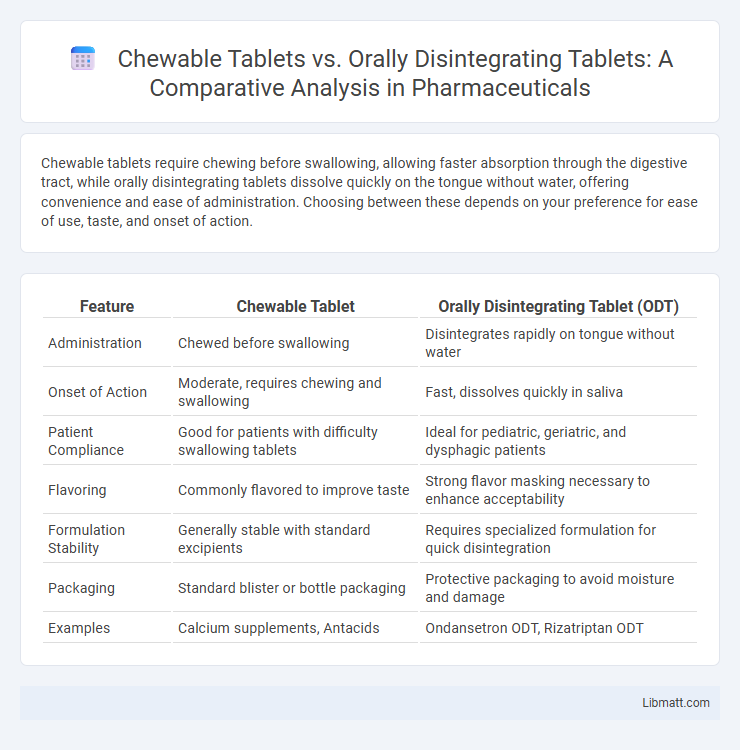Chewable tablets require chewing before swallowing, allowing faster absorption through the digestive tract, while orally disintegrating tablets dissolve quickly on the tongue without water, offering convenience and ease of administration. Choosing between these depends on your preference for ease of use, taste, and onset of action.
Table of Comparison
| Feature | Chewable Tablet | Orally Disintegrating Tablet (ODT) |
|---|---|---|
| Administration | Chewed before swallowing | Disintegrates rapidly on tongue without water |
| Onset of Action | Moderate, requires chewing and swallowing | Fast, dissolves quickly in saliva |
| Patient Compliance | Good for patients with difficulty swallowing tablets | Ideal for pediatric, geriatric, and dysphagic patients |
| Flavoring | Commonly flavored to improve taste | Strong flavor masking necessary to enhance acceptability |
| Formulation Stability | Generally stable with standard excipients | Requires specialized formulation for quick disintegration |
| Packaging | Standard blister or bottle packaging | Protective packaging to avoid moisture and damage |
| Examples | Calcium supplements, Antacids | Ondansetron ODT, Rizatriptan ODT |
Introduction to Chewable Tablets and Orally Disintegrating Tablets
Chewable tablets are solid dosage forms designed to be chewed before swallowing, enhancing ease of ingestion and rapid onset of action, often used for pediatric and geriatric patients. Orally disintegrating tablets (ODTs) dissolve quickly on the tongue without the need for water, improving compliance for individuals with swallowing difficulties. Your choice between these formulations depends on factors like patient preference, drug characteristics, and the desired speed of absorption.
Key Differences in Formulation
Chewable tablets are formulated with flavoring agents and binders to ensure they break down easily when chewed, facilitating gradual release and absorption through the digestive tract. Orally disintegrating tablets (ODTs) contain superdisintegrants that enable rapid dissolution within seconds on the tongue, allowing for swift absorption without the need for water. Your choice between the two depends on the desired onset of action, patient compliance, and ease of administration.
Mechanism of Administration
Chewable tablets require you to mechanically break the tablet by chewing, which aids in releasing the active ingredients gradually as the tablet is broken down in the mouth before swallowing. Orally disintegrating tablets (ODTs) dissolve rapidly on your tongue within seconds without the need for water, allowing for quick absorption through the oral mucosa. This fundamental difference in the mechanism of administration influences onset time and suitability for patients with swallowing difficulties.
Patient Compliance and Convenience
Chewable tablets enhance patient compliance by offering easy administration without water, making them ideal for children and individuals with swallowing difficulties. Orally disintegrating tablets (ODTs) dissolve rapidly in the mouth, providing convenience especially for elderly patients or those with limited access to water. Both formulations improve medication adherence by addressing specific patient needs related to ease of use and portability.
Onset of Action and Bioavailability
Chewable tablets typically have a faster onset of action compared to conventional tablets due to partial pre-digestion in the mouth, but their bioavailability may vary depending on swallowing and gastric absorption. Orally disintegrating tablets (ODTs) dissolve rapidly on the tongue, allowing for faster absorption through the oral mucosa and often resulting in quicker onset and improved bioavailability by bypassing first-pass metabolism. Studies show ODTs can provide enhanced bioavailability for drugs with significant hepatic metabolism, making them preferable in scenarios requiring rapid therapeutic effects.
Suitable Patient Populations
Chewable tablets are ideal for children and patients who have difficulty swallowing whole pills, as they allow for gradual breakdown through chewing. Orally disintegrating tablets (ODTs) rapidly dissolve on the tongue without water, making them suitable for elderly patients or those with dysphagia. Your healthcare provider can help determine which tablet form best suits your specific swallowing needs and preferences.
Taste and Palatability Factors
Chewable tablets are designed to be chewed before swallowing, often flavored to mask the bitter taste of active ingredients, enhancing your overall intake experience. Orally disintegrating tablets dissolve quickly on the tongue without the need for water, relying on sweeteners and flavoring agents to improve palatability while ensuring rapid absorption. Both formulations prioritize taste and sweetness to maximize patient compliance, with chewables typically offering more robust flavor profiles and orally disintegrating tablets focusing on immediate taste masking and mouthfeel.
Storage and Stability Considerations
Chewable tablets require storage in a cool, dry place to prevent moisture absorption, which can compromise their texture and potency, whereas orally disintegrating tablets (ODTs) demand strict protection from humidity and temperature fluctuations due to their rapid dissolution properties. Your choice between the two should consider ODTs' sensitivity to moisture, necessitating specialized packaging like blister packs with desiccants to maintain stability. Proper storage conditions significantly extend the shelf life and ensure the efficacy of both dosage forms, with chewable tablets generally being more robust under standard conditions.
Common Uses and Indications
Chewable tablets are commonly used for pediatric patients and individuals with swallowing difficulties, often indicated for vitamins, antacids, and allergy medications. Orally disintegrating tablets (ODTs) dissolve quickly on the tongue, making them ideal for patients needing rapid drug onset or those who cannot swallow pills, frequently prescribed for antiemetics, antipsychotics, and migraine treatments. Both formulations enhance medication adherence by offering convenient administration for conditions requiring consistent dosing.
Which Option is Better?
Chewable tablets offer the advantage of ease in swallowing and faster absorption due to mastication, making them ideal for patients who dislike swallowing pills. Orally disintegrating tablets dissolve quickly on the tongue without water, providing convenience and rapid onset of action for those with swallowing difficulties or on-the-go needs. The better option depends on patient preference, medical condition, and required speed of drug absorption, with chewable tablets favored for taste masking and orally disintegrating tablets preferred for rapid dissolution and portability.
Chewable Tablet vs Orally Disintegrating Tablet Infographic

 libmatt.com
libmatt.com